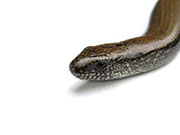- Navigating Your Midlife Crisis: Embracing New Possibilities
- City Raccoons Showing Signs of Domestication
- Mapping the Exposome: Science Broadens Focus to Environmental Disease Triggers
- One Week Less on Social Media Linked to Better Mental Health
- Your Brain Changes in Stages as You Age, Study Finds
- Some Suicide Victims Show No Typical Warning Signs, Study Finds
- ByHeart Formula Faces Lawsuits After Babies Sickened With Botulism
- Switch to Vegan Diet Could Cut Your Greenhouse Gas Emissions in Half
- Regular Bedtime Does Wonders for Blood Pressure
- Dining Alone Could Mean Worse Nutrition for Seniors
Deadly Fungus Killing U.S. Snakes Similar to That Seen in Bats


For years, a deadly fungus has been decimating bat populations across the United States. Now scientists say a similar, often fatal, fungal infection is killing snakes as well.
The snake fungus, called Ophidiomyces ophiodiicola and the bat fungus, known as Pseudogymnoascus destructans and called “white-nose syndrome,” both emerged about a decade ago.
The fungi inhabit different environments and prefer different temperature and humidity ranges, the scientists said. However, they do share traits that allow them to live in a variety of habitats and infect various species of snakes and bats.
“The fungus killing these snakes is remarkably similar in its basic biology to the fungus that has killed millions of bats,” study co-author Andrew Miller, of the University of Illinois at Urbana-Champaign, said in a university news release.
“It occurs in the soil, seems to grow on a wide variety of substances, and it possesses many of the same enzymes that make the bat fungus so persistent,” he explained.
“The snake fungus has the ability, just like the bat fungus, to live as a saprobe, consuming dead organic matter,” Miller said. “It doesn’t need the animal to live, but it’s out there attacking the animal now. Why is it doing it? I don’t know.”
Both types of fungus emerged in North America in the mid-2000s and are sweeping across the United States and parts of Canada. The fungal infection in bats has a death rate of more than 90 percent.
The fungal infection in snakes feeds on keratin, found in snake scales. Infection causes scabs, nodules, abnormal molting, ulcers and other skin and tissue damage, the researchers said, and the death rate is 100 percent.
Whether every North American snake is vulnerable is unclear. According to the researchers, snakes affected by the fungal disease include northern water snakes, eastern racers, rat snakes, timber rattlesnakes, Eastern massasaugas, pygmy rattlesnakes and garter snakes.
“We know that the fungus is out there, we know that it’s killing snakes, but is it killing healthy snakes or is it killing snakes that are already weakened from some other cause?” said study co-author Matthew Allender, who was the first to report the snake fungal disease in rattlesnakes in Illinois.
Habitat loss, pollution, severe weather and stress from human encroachment may all worsen snake health, potentially making them more susceptible to disease, he said.
The beleaguered snakes do have human allies: Allender co-chairs a recently formed group, linked to Partners for Amphibian and Reptile Conservation, to help research and fight the fungal threat.
“This is a collaborative effort among biologists, veterinarians and habitat managers to actually assess the risks and minimize the effects of disease,” Allender said.
The study was published recently in the journal Fungal Ecology.
More information
The U.S. Centers for Disease Control and Prevention has information about fungal diseases in people.
Source: HealthDay
Copyright © 2025 HealthDay. All rights reserved.










